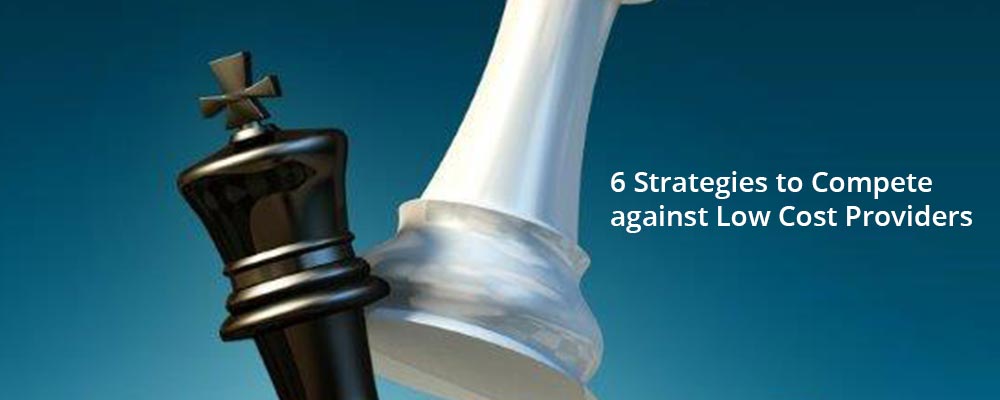 If you’re like most sales representatives in the market today, you are likely competing against low cost providers more often than not.
If you’re like most sales representatives in the market today, you are likely competing against low cost providers more often than not.
If you deal with low cost providers, read on. Chances are one or more of these strategies will be worth trying or a valuable reminder.
Strategy #1 – Know Your Value
Knowing your company’s value, or the value of your service, makes a tremendous difference in the way you approach price issues. The key is to know it at a deep internal level as it creates the conviction you need to demonstrate the difference between what the customer gets when they deal with your company versus the low cost provider. And, should you feel there is no difference, don’t undervalue the difference that YOU bring to your customer.
This, of course, means doing research to gain insight into what differentiates your company. It might be external research or at times it may be knowledge you need to tap into by listening and asking questions within your own company.
Strategy #2 – Embrace Price Objections Like a Favorite Treat
Okay this one likely has you thinking I’m nuts. Before you write me off completely, bear with me for a minute!
I was coaching a team of sales representatives who were dealing with a lot of price pressure in their market. They had margin levels to meet and it was a struggle. One of the reps admitted she found it hard to handle price issues and she dreaded the inevitable push back on the price when she presented a quote.
Here’s the thing, if you know you aren’t the cheapest in the market, why wait for the customer to tell you so!
So we had a bit of a fun challenge, and if this is something you face, I encourage you to try it.
The challenge was for Danielle to absolutely embrace and love price objections. Not just to become comfortable with them, but to get excited that she had the opportunity when presented with a price issue to share why her company, her products, her solution were a better deal! When a customer raised a price issue, Danielle was being given a gift, an opportunity to share why her solution was better value!
 The most rewarding part of this challenge is Danielle undertook all of these strategies and she was able to shift her thinking. Price objections became fun instead of the dreaded part of a selling process.
The most rewarding part of this challenge is Danielle undertook all of these strategies and she was able to shift her thinking. Price objections became fun instead of the dreaded part of a selling process.
Strategy #3 – When You are a Price Leader Address Price FIRST!
Once you embrace price and get excited about it, you are in a position to be proactive.
Instead of avoiding it, fretting over it, apologizing or blaming your company for being a higher cost…you own it!
Owning it means you go first and you are proud to share why your company is either a price leader or “not” always the lowest cost provider. You share it in terms of what it means to the customer and why you are the greatest value.
Sharing this after you have built trust or perhaps as part of the trust building process, can actually help to position you and your company as the authority. You are able to share why companies chose you over low cost providers. And you are able to share customer examples that they can relate to that separate price from cost.
Strategy #4– Tap into Your Company’s Customer Examples
 Sometimes this insight comes from listening to the customer’s experiences with your company. These experiences, particularly when a customer leaves for a lower price and comes back, are important indicators on what your customers value.
Sometimes this insight comes from listening to the customer’s experiences with your company. These experiences, particularly when a customer leaves for a lower price and comes back, are important indicators on what your customers value.
As an example, one of our clients we dealt with is a price leader in their space. They had a large account with a customer they had been dealing with for some time. The customer was market testing and issued a RFP. Our client lost the account as their hourly fees for service were undercut by over half by a low cost provider.
In less than 12 months, the client was back. They discovered that price was truly relative. The low cost provider’s technicians did not have the depth of knowledge and training that was needed to fix problems quickly. A typical service call that should have taken an hour or two was taking two, three or four times longer. And worse! Sometimes they couldn’t fix the problem.
The client broke their contract with the low cost provider and came back!
Imagine how much grief you can save a customer by helping them to see the difference between PRICE and COST!
Strategy #5 – Self-Evaluate is Price your Nemesis?
Years ago, I was working with a major plumbing distribution company and developing their sales force across the country. I was fairly new in the sales training business and so perhaps it was for this reason that this aha stuck with me.
You see there were 3 sales representatives who were successful, yet success came in different colors and patterns for each of them.
The top rep, had half of a major city as his territory, the next rep had the other half, and the third rep had a different city that was substantially smaller.
In this company a sales rep had a price list and could choose their pricing level, which in turn impacted their margin level and, of course, their commission level.
The Top Rep = Highest Volume + Healthy Margin
The top rep (Rep #1) did a high volume of business; he had some large accounts that demanded good prices. Yet his margin level was still quite good, not the highest in the company but quite healthy. Consequently, he made a really good commission level.
The Next Highest Volume Rep = High Volume + Low Margin
The other rep (Rep #2) who had half of this large city did a high level of volume. Not as high as the top rep did, but it was a good volume. Yet his margin level was always really low, usually one of the lowest in the company. Consequently, for the volume he managed, he made less than the top reps and less than many of the mid-level reps.
A Mid Volume Rep = Mid Volume + Highest Margin
The third rep (Rep #3) in the other smaller city, did lower volumes than the 2 reps in the major city. He was consistent in his volumes and interestingly enough he had the highest margins. He made almost us much as Rep #1 with lower volumes.
My aha?
Rep #2 had similar market opportunities to Rep #1. He could have made a really healthy income and created better outcomes for the company. The aha was that Rep #2 had a belief system that got in his way. Price was his nemesis. He believed his market was different. He believed he had to be cheaper to compete. He believed it so strongly that he was always undervaluing his company’s value proposition and worse, himself.
Price issues would follow him for life, unless he chose to embrace price and make it his ally.
Strategy #6 – Renew by Reviewing How You Make a Difference
 There is no doubt you will lose business on price. Sometimes the prospect is simply not a good fit. Sometimes they will buy on price. Sometimes they may come back to you when they discover price is different than cost. And sometimes you will lose a great prospect as someone else is able to undercut you and service their needs.
There is no doubt you will lose business on price. Sometimes the prospect is simply not a good fit. Sometimes they will buy on price. Sometimes they may come back to you when they discover price is different than cost. And sometimes you will lose a great prospect as someone else is able to undercut you and service their needs.
Standing back and reviewing the solutions you are providing to your customers and how you are helping them to be more competitive and to win in their market, is a great way to renew yourself. It helps you to maintain your conviction and it’s a reminder you truly are providing great value to your customers!
Happy Selling!

